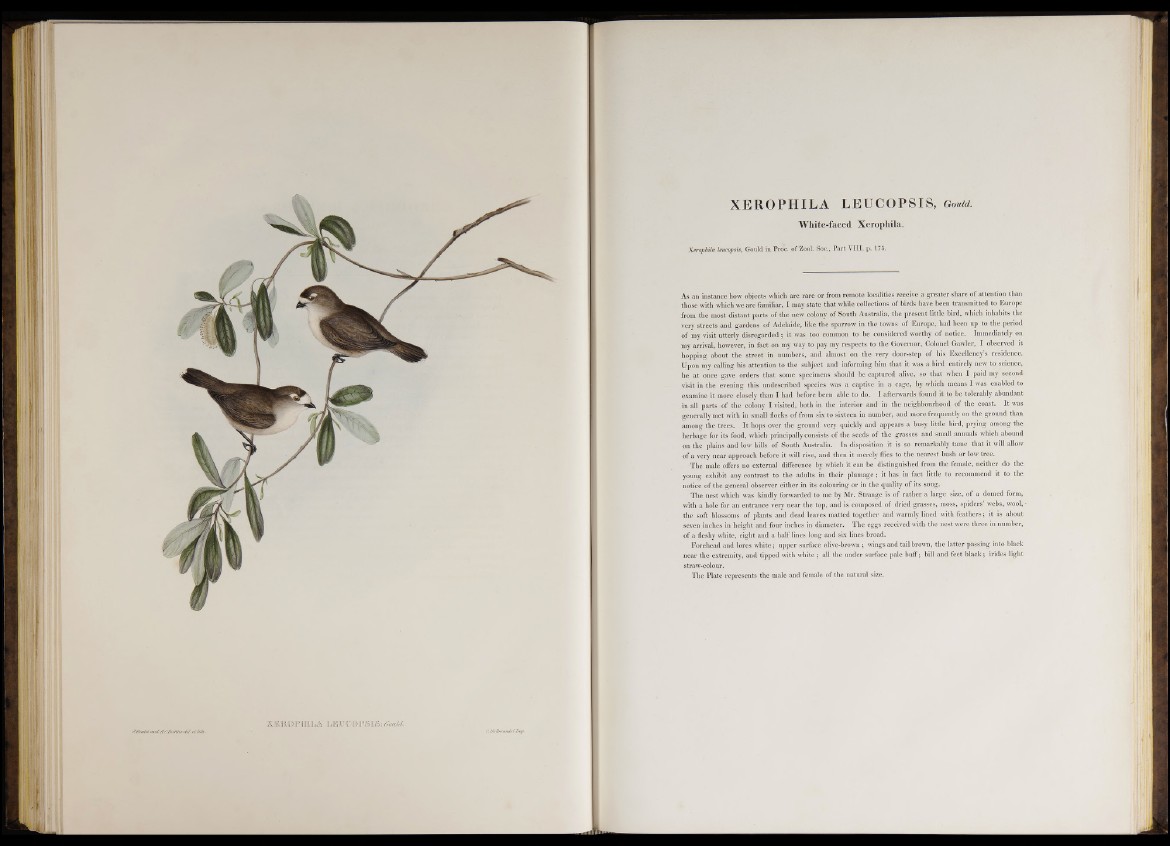
LEROFHTILj L E U C O F S I S : ^ ^
XEROPHILA LEUCOPSI S, Gould.
White-faced Xerophila.
Xerophila leucopsis, Gould in Proc. of Zool. Soc., Part VIII. p. 175.
As an instance how objects which are rare or from remote localities receive a greater share o f attention than
those with which we are familiar, I may state that while collections o f birds have been transmitted to Europe
from the most distant parts o f the new colony o f South Australia, the present little bird, which inhabits the
very streets and gardens o f Adelaide, like the sparrow in the towns o f Europe, had been up to the period
of my visit utterly disregarded ; it was too common to be considered worthy of notice. Immediately on
my arrival, however, in fact on my way to pay my respects to the Governor, Colonel Gawler, I observed it
hopping about the street in numbers, and almost on the very door-step o f his Excellency’s residence.
Upon my calling his attention to the subject and informing him that it was a bird entirely new to science,
he at once gave orders that some specimens should be captured alive, so that when I paid my second
visit in the evening this undescribed species was a captive in a cage, by which means I was enabled to
examine it more closely than I had before been able to do. I afterwards found it to be tolerably abundant
in all parts o f the colony I visited, both in the interior and in the neighbourhood o f the coast. It was
generally met with in small flocks o f from six to sixteen in number, and more frequently on the ground than
among the trees. It hops over the ground very quickly and appears a busy little bird, prying among the
herbage for its food, which principally consists of the seeds o f the grasses and small annuals which abound
on the plains and low hills of South Australia. In disposition it is so remarkably tame that it will allow
o f a very near approach before it will rise, and then it merely flies to the nearest bush or low tree.
The male offers no external difference by which it can be distinguished from the female, neither do the,
young exhibit any contrast to the adults in their plumage; it has in fact little to recommend it to the
notice o f the general observer either in its colouring or in the quality o f its song.
The nest which was kindly forwarded to me by Mr. Strange is of rather a large size, o f a domed form,
with a hole for an entrance very near the top, and is composed of dried grasses, moss, spiders webs, wool,
the soft blossoms o f plants and dead leaves matted together and warmly lined with feathers; it is about
seven inches in height and four inches in diameter. The eggs received with the nest were three in number,
o f a fleshy white, eight and a half lines long and six lines broad.
Forehead and lores white; upper surface olive-brown ; wings and tail brown, the latter passing into black
near the extremity, and tipped with white ; all the under surface pale buff; bill and feet black; irides light
straw-colour.
The Plate represents the male and female o f the natural size.